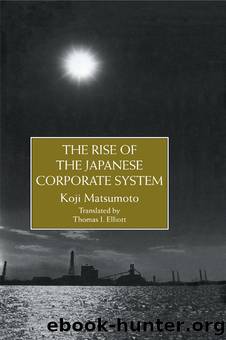Rise Of The Japanese Corporate S by Matsumoto

Author:Matsumoto [Matsumoto]
Language: eng
Format: epub
Tags: Social Science, Anthropology, General, Ethnic Studies, Regional Studies
ISBN: 9781136153303
Google: wNrGBQAAQBAJ
Publisher: Routledge
Published: 2013-10-28T05:53:18+00:00
Features of the corporate organization in Japan
In form, most companies in Japan also have a corporate organization designed to act as a controlling mechanism. This is merely a front, however, and the real workings of the organization take place in a way that is often totally unrelated to the official organization. This does not simply mean that a few Japanese modifications have been made to what is still essentially a Western-style controlling mechanism. The organization of Japanese corporations stems from a fundamentally different set of principles. None of the features so commonly attributed to the Japanese corporate organization â so-called bottom-up or consensus-style decisionmaking; emphasis on âharmonyâ; unclear boundaries for responsibility and authority; an organization revolving around people â could possibly exist under the organizational principles of a Western-style controlling mechanism.
A controlling mechanism organization is structured so that no contradiction and no duplication exist between the boundaries of authority and responsibility relating to each job position. Given that one of the features of the Japanese-type corporate organization is the relatively vague nature of boundaries relating to authority and responsibility, as a matter of course an organization of this nature should have difficulty functioning in an organized and coordinated manner. In addition, it is inconceivable that the organization would be able to find jobs to suit people. It is only possible for an organization to function in an organized and coordinated manner when particular tasks are assigned to each job position and those tasks are carried out as stipulated. If the nature of the jobs and tasks involved is changed to suit the capabilities and personalities of the people performing them, it is obvious that the organization will fall into chaos. As long as the consensus system is also based on the control mechanism organization principle, it will never be achievable. The organization itself constitutes an independent linking of decision-making carried out within the framework of separate jobs. Consensus-style decision-making must effectively be perceived as something which introduces the participation of unrelated parties into a decision-making process which should really be carried out within predetermined boundaries of authority and responsibility, and would surely lead to a complete breakdown in the order of the organization.
The concept of bottom up, also, is at the very least a form of decision-making that could not be completely contained within the framework of this type of organization.
As long as they are evaluated in terms of the organizational principles on which the capitalist corporate system operates, all of the features of the Japanese-style corporate organization must be considered as obviously rendering the organization ineffective, causing confusion and being extremely dubious in terms of their capacity even to support or maintain the organizational structure. In reality, however, it cannot be denied that Japanese companies, far from being reduced to a state of confusion, are functioning quite well. This clearly demonstrates that Japanese companies are in fact operating under a system that is based on totally different organizational principles from those which exist in the West.
Japanese companies do not organize workers; they organize corporate employees.
Download
This site does not store any files on its server. We only index and link to content provided by other sites. Please contact the content providers to delete copyright contents if any and email us, we'll remove relevant links or contents immediately.
Harry Potter and the Goblet Of Fire by J.K. Rowling(3025)
Never by Ken Follett(2872)
Shadow of Night by Deborah Harkness(2710)
Ogilvy on Advertising by David Ogilvy(2677)
Zero to IPO: Over $1 Trillion of Actionable Advice from the World's Most Successful Entrepreneurs by Frederic Kerrest(2374)
The Man Who Died Twice by Richard Osman(2289)
Machine Learning at Scale with H2O by Gregory Keys | David Whiting(2264)
Book of Life by Deborah Harkness(2259)
How Proust Can Change Your Life by Alain De Botton(2255)
My Brilliant Friend by Elena Ferrante(2217)
0041152001443424520 .pdf by Unknown(2214)
The Tipping Point by Malcolm Gladwell(2200)
How to Pay Zero Taxes, 2018 by Jeff A. Schnepper(2094)
Will by Will Smith(2032)
Purple Hibiscus by Chimamanda Ngozi Adichie(1977)
Hooked: A Dark, Contemporary Romance (Never After Series) by Emily McIntire(1932)
Borders by unknow(1779)
Rationality by Steven Pinker(1760)
Daughter of Smoke and Bone by Laini Taylor(1737)
